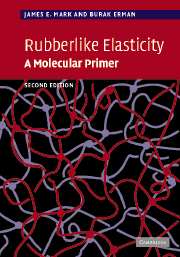Book contents
- Frontmatter
- Contents
- Preface to the first edition
- Preface to the second edition
- Part I Fundamentals
- 1 Introduction
- 2 Some rubberlike materials
- 3 The single molecule: theory and experiment
- 4 Preparation and structure of networks
- 5 Elementary statistical theory for idealized networks
- 6 Statistical theory for real networks
- 7 Elastic equations of state and force–deformation relations
- 8 Swelling of networks and volume phase transitions
- 9 Force as a function of temperature
- 10 Model elastomers
- Part II Additional topics
- Appendix A Relationships between ν, ξ and Mc
- Appendix B Relationships between 〈r2〉, 〈(Δr)2〉, 〈r2〉0, and ϕ
- Appendix C Equations of state for miscellaneous deformations from the constrained junction theory
- Appendix D Thermodynamics of the relationship of stress to temperature
- Problems
- Answers to problems
- Some publications describing laboratory/classroom experiments or demonstrations
- References
- Index
4 - Preparation and structure of networks
from Part I - Fundamentals
Published online by Cambridge University Press: 04 December 2009
- Frontmatter
- Contents
- Preface to the first edition
- Preface to the second edition
- Part I Fundamentals
- 1 Introduction
- 2 Some rubberlike materials
- 3 The single molecule: theory and experiment
- 4 Preparation and structure of networks
- 5 Elementary statistical theory for idealized networks
- 6 Statistical theory for real networks
- 7 Elastic equations of state and force–deformation relations
- 8 Swelling of networks and volume phase transitions
- 9 Force as a function of temperature
- 10 Model elastomers
- Part II Additional topics
- Appendix A Relationships between ν, ξ and Mc
- Appendix B Relationships between 〈r2〉, 〈(Δr)2〉, 〈r2〉0, and ϕ
- Appendix C Equations of state for miscellaneous deformations from the constrained junction theory
- Appendix D Thermodynamics of the relationship of stress to temperature
- Problems
- Answers to problems
- Some publications describing laboratory/classroom experiments or demonstrations
- References
- Index
Summary
Preparation of networks
A network is obtained by linking polymeric chains together into the form of a three-dimensional structure such as that shown in Figure 1.2. The process is generally known as cross linking, curing, or vulcanization (Coran, 1987, 2005; Akiba and Hashim, 1997; Ignatz-Hoover and To, 2004). The points of linking, called cross links or junctions, may be (1) randomly located along the chains, or (2) restricted to specific locations such as the chain ends or selected repeat units, particularly in the case of bioelastomers (Gosline, 1987; Lillie and Gosline, 1990; Erman and Mark, 1997). The required linking (cross linking or end linking) can be brought about by chemical reactions that form covalent bonds between chains, either randomly or controllably at chosen locations. The linking may also be accomplished, randomly, by the physical aggregation of units from two or more chains. The simplicity of the first technique and the permanence of the structures it provides are advantages for many applications. The main advantage of the second technique is the fact that the elastomer is frequently reprocessable, since the aggregation process is often reversible.
Random chemical reactions
The most important examples of cross linking using chemical reactions that attack the chains at random locations are given in the top part of Table 4.1.
Sulfur is used primarily with elastomers having numerous unsaturated groups, for example, those in the repeat units of the polyisoprenes and polybutadienes.
- Type
- Chapter
- Information
- Rubberlike ElasticityA Molecular Primer, pp. 39 - 48Publisher: Cambridge University PressPrint publication year: 2007



